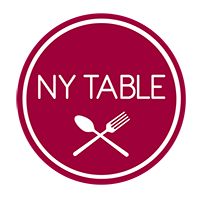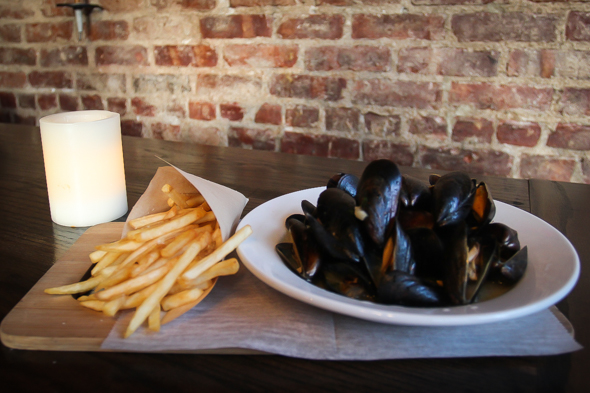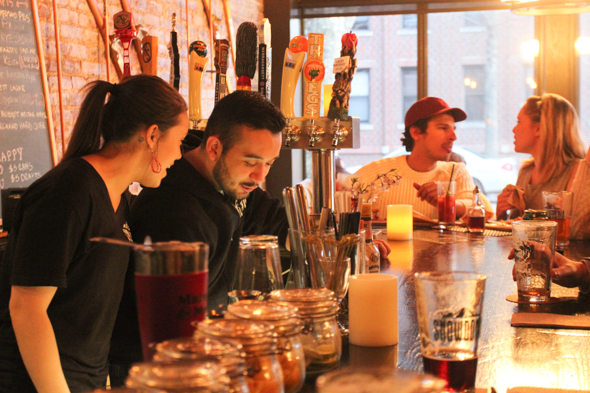Restaurants Put Queens on the Food Map, to Mixed Response
By Esha Mahajan
Jesse Tang tries to accommodate a table for 19 people at his sushi restaurant, Pink Nori, on a recent Friday evening. He also answers phone calls, seats walk-in customers, and hands out menus, during one of the busiest weeks since the restaurant opened in Astoria, Queens, in February, in the throes of winter.
Tang, 22, works six days a week to cut costs at the restaurant he opened in a neighborhood that has grown tremendously within the past few months, especially in the food and hospitality industry.
Pink Nori is one of the roughly 560 area restaurants that serve over 55 different cuisines. An April 2014 report on Astoria released by the New York City Economic Development Corporation says that the number of accommodation and food service establishments in the neighborhood grew by over 50 percent from 2001 to 2011, and were responsible for over 32 percent of all new establishments in Astoria. Full service restaurants in the neighborhood increased by 57 percent during the same period.
“New yuppie types are moving in to the borough, so there are newer, fancier restaurants,” says Rob MacKay, director of public relations at the Queens Economic Development Corporation, a nonprofit that represents the borough’s community and business sectors. “Theme restaurants, wine bars, and places with upscale cuisine that would reflect Manhattan more are coming to western Queens (Astoria, Long Island City, and Sunnyside).”
There’s a huge growth spurt — and with it, a challenge to established businesses to adapt or fall behind. George Halvatzis, whose Halvatzis Realty has specialized in Astoria for over 25 years, says that businesses are getting priced out in Brooklyn and Manhattan, and moving to Astoria, where the rents are relatively more affordable. “Astoria is going nuts,” he said. “It’s becoming a named area, and everybody knows it now.”
Meg Cotner, author of the book “Food Lover’s Guide to Queens,” says that people like to describe the newer places as more “Brooklyn-type,” and admits that many of the new restaurants cater to an upwardly mobile young crowd. “Cocktail prices are higher, and some food does not always reflect the neighborhoods, especially Astoria, which is historically Greek and Italian,” she said. The Corporation’s report says that of all the cuisines, Astoria has the most American restaurants, 111 of them.
Despite concerns from long-time residents, the population shift continues. The report, which crunched data from the 2010 Census, says that the percentage of the Astoria population between the ages of 25 to 34 increased to 26.3 in 2010 from 22.9 in 2000.
When Halvatzis renovates rental apartments, now, he removes the 30-inch stove and replaces it with a 24-inch one, because his new tenants don’t want to cook.
It’s a case of the chicken and the egg — are more people moving to the borough because of the diverse food options, or are more entrepreneurs opening restaurants to cater to the influx? It’s hard to say, but they’re doing everything they can to survive in a highly competitive business.
Pink Nori is casual, despite the red rope light that runs along the edge of the bar and sushi counter, and lights up the shelves that hold bottles of liquor. The biggest draw is their untraditional menu — sushi pizza, which comprises a scallion pancake topped with guacamole and fish, sushi with potato chips, Cajun tuna roll, and “Make Your Own Sushi,” where customers create combinations for chef Andy Tan, who has worked at legendary restaurants including Gari, Morimoto and Nobu, to roll for them. Diners can choose from a list of ingredients that include guacamole, asparagus, potato chips, mangoes, and other vegetables and fish.
“The unique menu brings people in initially, but once they come they try other dishes also,” says Tang.
Twist and Smash’d, a burger restaurant in Forest Hills that opened in November 2013, and is already famous for its crispy twisted potatoes, is expanding to Steinway Street in Astoria in the first weekend of May. Brianna Cano, whose family owns the restaurant, says it’s a brand-building strategy. The new 5,000 square foot space, Twist and Smash’d Sports, will have a bigger menu, 57 flat-screen televisions, and indoor bocce (an Italian bowling game). It is in front of the Steinway Street M and R subway station, providing easy accessibility to and from Manhattan. They’re also expanding their current location to include an outdoor patio.
One way to ease the transition from old to new is to create a link to the community. Twist and Smash’d posts clouds of information to show their customers they care — we compost, we are green, we give back, we care about your food. Drawings of favorite dishes by local kids hang framed on another wall. They provide samples of their burgers to local businesses, partner with local organizations such as the Forest Hills High School music program and the Forest Hills Chamber of Commerce, and work with nonprofits such as City Harvest.
The expansion of Coffeed, a Long Island City cafe that opened in September 2012 and is opening a fourth branch overlooking the waterfront at Hunt’s Point this May, is in part an attempt to reduce the risk of operations, says owner Frank Turtle, who works at the flagship in Long Island City during the day to save on labor costs, taking orders behind the counter, and serving coffee to his customers.
The cashier wears a beanie, beaded bracelets on both wrists, and a neckpiece, and has a pierced lower lip. Young 20-somethings sit on wooden communal tables, high stools, and a comfortable looking couch with their Macbooks out, and the song Volare softly plays in the background. Occasionally Coffeed holds open mic nights for musicians, comedians, poets and other artists, and events where vendors bring in crafts and food. The menu is carnivore, vegetarian and vegan friendly; their pastries vegan and gluten-free. Much of their produce also comes from the Brooklyn Grange farm on the roof of the building.
At Snowdonia, a gastropub in Astoria that opened in April 2013, co-owner Tom Davies tended bar wearing a black Snowdonia hoodie on a recent Friday evening. It’s a neighborhood pub with wooden bench seating, two mounted flat screens that play anything from old Hitchcock films to Game of Thrones episodes, and soft music. They grind their own coffee beans, sourced from Astoria Coffee, run by a local couple that is also opening a brick and mortar cafe.
Men and women in their late twenties or early thirties sit on the wooden benches and bar stools with pints of beer by their side and munch on food served on wooden chopping boards. Their chef, Will Lubold, who previously worked at ‘inoteca on the Lower East Side, created a beer-infused menu including oatmeal stout panna cotta, beer battered fish and chips, mussels in beer, and a bourbon brownie.
They hold trivia nights, Flights and Bites three-course dinners paired with beer from a local brewery, and Monday brunches to cater to freelancers with irregular working hours. But a strong social media presence is one of their biggest growth strategies. They started online beer deliveries after customers posted requests on their Facebook page. Matthew Callahan, who handles marketing for Snowdonia, says social media are an effective and inexpensive way to get the word out.
Pink Nori has an active Facebook page with pictures of beautifully plated dishes, but no website yet; Twist and Smash’d tweeted about the outdoor patio they’re opening at their Forest Hills location, and tweet to followers as well; Snowdonia has live Facebook, Twitter, and Instagram feeds on their website homepage. Coffeed’s Facebook page has nearly 6,000 likes, and a recent picture from a marriage proposal at the cafe.
Halvatzis says that many of the area’s successful businesses are food related — but so are some of the casualties. Longstanding businesses including Pasta del Giorno and Santa Fe steakhouse in Forest Hills, and homemade ice cream shop Malu in Long Island City recently closed down. Uncle George’s Greek Tavern, which opened in Astoria in the 1970s, closed last year, after a rent dispute.
Not everyone is pleased by the trend. “I’ve been going to many of these family owned places for years, and to see them gone or turned into gastro pubs is disappointing,” says Veronica Nizama, 27, a graphic designer and illustrator who lives in Forest Hills with her husband. “I moved to Forest Hills because it seemed like a beautiful, family friendly area. If I wanted to be surrounded by ‘cool’ gastro pubs, I’d live in Manhattan or Brooklyn.” She also says that the prices at some of the newer places are “ridiculous.”
Cotner, who also publishes the blogs, “We Hear Astoria,” “We Heart LIC,” and “We Heart Sunnyside,” is wary of the changes, and not only from a food perspective. “I do not want to be priced out of the neighborhood,” she says. “The $5,000 rental made me very anxious,” she adds, referring to a three-bedroom duplex on 35th Street in Astoria that set a neighborhood rental record in April.
Older restaurants that have managed to survive the evolution of the in Queens’ dining scene have had to adapt. Christopher Vlacich, who owns Piccola Venezia, the Astoria restaurant his father opened in 1973, says they’ve made adjustments to the menu to stay current, including expanding the wine selection and adding gluten-free pasta. “Many good and special restaurants are opening here, and if you’re doing the right thing, you will benefit from the increase in traffic due to this,” he says. “The places that closed down were, perhaps, not special.”
Tags: gentrification, Queens, restaurants


Your Comments